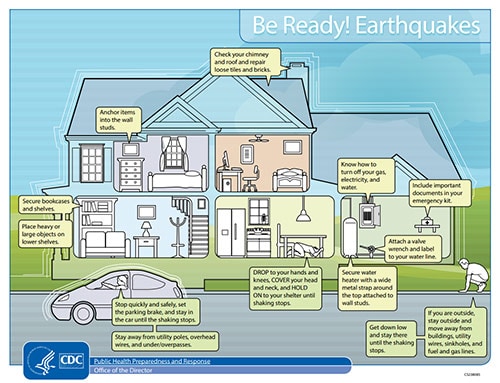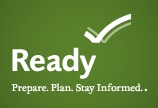Preparing for an Earthquake

There are many places in the United States, called “fault zones,” that are at risk for serious earthquakes. These include states along the west coast, in the south, and in the central United States. While very strong or intense earthquakes are rare, less powerful earthquakes can also be dangerous. The key to surviving an earthquake and reducing your risk of injury lies in planning, preparing, and practicing what you and your loved ones will do if it happens.

Be Ready! Earthquakes Infographic
Learn more > [PDF - 143 KB]
Know the signs of an earthquake.
During an earthquake, you may hear a roaring or rumbling sound that gradually gets louder. You may also feel a rolling sensation that starts out gently and, within a second or two, grows violent.
OR
You may first be jarred by a violent jolt. A second or two later, you may feel shaking and find it difficult to stand up or move from one room to another.
Learn the safe spots.
During an earthquake, most deaths and injuries are caused by collapsing building materials and heavy falling objects, such as bookcases, cabinets, and heating units.
- Learn the safe spots in each room of your home. A safe spot may be underneath a sturdy table away from walls or underneath your covers with a pillow over your head if you are already in bed.
Plan and practice what to do if an earthquake strikes.
By planning and practicing what to do if an earthquake strikes, you and your loved ones can learn to react correctly and automatically when the shaking begins.
- Get the entire family to practice an earthquake drill, especially if you have children. Participating in an earthquake drill will help you and your loved ones understand what to do in case you are not with them during an earthquake.
- Make sure you and your children also understand the school’s emergency procedures for disasters. This will help you coordinate where, when, and how to reunite with your children after an earthquake.
Drop, cover, and hold on during your earthquake drill.
- DROP down onto your hands and knees immediately. This position protects you from falling but still allows you to move if necessary.
- COVER your head and neck (and your entire body if possible) underneath a sturdy table or desk. If there is no shelter nearby, get down near an interior wall or next to low-lying furniture that won’t fall on you, and cover your head and neck with your arms and hands. Try to stay clear of windows or glass that could shatter or objects that could fall on you.
- HOLD ON to your shelter (or to your head and neck) until the shaking stops. Be prepared to move with your shelter if the shaking shifts it around.
Create an evacuation plan.
If an earthquake happens, you and your loved ones may need to evacuate a damaged area afterward. By planning and practicing for evacuation, you will be better prepared to respond appropriately and efficiently to signs of danger or to directions by civil authorities.
- Take a few minutes with your family to discuss a home evacuation plan. Sketch a floor plan of your home, walk through each room, and discuss evacuation details. If you live downstream from a dam, know flood-zone information.
- Plan a second way to exit from each room or area, if possible. If you need special equipment, such as a rope ladder, mark where it is located.
- Mark where your emergency supply kit (including food, water, first aid) and fire extinguishers are located.
- Locate where the utility switches or valves are located so that they can be turned off, if possible.
- Indicate the location of your family’s emergency outdoor meeting place.
Create an emergency supply kit.
Stock up on emergency supplies that can be used after an earthquake. These supplies should include a first aid kit and emergency supply kits for the home and automobile, including emergency water and food. Store enough supplies to last at least 3 days.
You should also make a list of important information (like telephone numbers of emergency contacts, insurance information, and important medical information) and gather any important documents (like medical documents, birth certificates, and passports). Store these items in a secure location like a fireproof or waterproof safe.
Items for your home
Assemble an emergency supply kit for your home. In addition to your standard emergency supply kit, some additional items that may help after an earthquake include the following:
- An ax
- A shovel
- A broom
- A rope for towing or rescue
- Sturdy shoes that can provide protection from broken glass, nails, and other debris
- Gloves (heavy and durable for cleaning up debris)
- Fire extinguisher (multipurpose, dry chemical type)
- A whistle or other signaling device carried in your purse or backpack
Prepare your home for earthquakes
Secure hazards in your home.
Tips for Securing Shelves
To keep items from falling off open shelves, attach a wooden or metal guardrail to each shelf. You can also use fishing line for a less visible alternative.
You should also make sure to place heavy or large objects on lower shelves. Use Velcro®-type fastenings to secure some items to their shelves.
Make sure to inspect your home and its surrounding for any possible hazards and secure them if you can. Remember: anything can move, fall, or break during an earthquake or its aftershocks.
- Identify potential hazards in each room, including windows and other glass items, unanchored bookcases, furniture that can topple, items on shelves, and areas that could be blocked by falling debris. Secure them, where possible, with “L” brackets, corner brackets, aluminum molding, or eyebolts.
- Secure cabinet doors by installing sliding bolts or childproof latches.
- Secure your large appliances (like refrigerators, water heaters, and stoves) with flexible cable, braided wire, or metal strapping. Wrap your water heater and attach it to wall studs.
- Move heavy mirrors and pictures hanging above beds, chairs, and other places where you sit or sleep. Otherwise, anchor these items with wire through eye screws bolted into wall studs. Or place screws on both sides, top, and bottom of the frame and screw these into the studs.
- Replace heavy ceramic or glass hanging planters with light-weight plastic or wicker baskets.
- Identify poisons, solvents, or toxic materials in breakable containers and move these containers to a safe, well-ventilated storage area. Keep them away from your water storage and out of reach of children and pets.
Inspect and secure your home’s structure.
Examine the structural safety of your house. If your house is of conventional wood construction, it will probably be relatively resistant to earthquake damage, particularly if it is a single-story structure.
- Strengthen the areas of connection between beams, posts, joists, and plates using “T” and “L” straps, mending plates, joist hangers, twin post caps, and nails and lap screws. Pay particular attention to exposed framing in garages, basements, porches, and patio covers.
- Check your chimney or roof for loose tiles and bricks that could fall in an earthquake. Repair loose tiles or bricks, as needed.
- Protect yourself from falling chimney bricks that might penetrate the roof, by reinforcing the ceiling immediately surrounding the chimney with 3/4-inch plywood nailed to ceiling joists.
For information on structural safety standards and qualified contractors in your area, contact your city or county government office on community development or building code enforcement. If you want to do the work yourself, many hardware or home-improvement stores will assist you with information and instructions.
Shut off utilities.
- Know where and how to shut off utilities, including gas, electricity, and water, at the main switches or valves. Check with your local utility companies for instructions.
- Teach all family members how and when to shut off utilities.
- Visit Safety Skills: Ready.gov to learn more.


